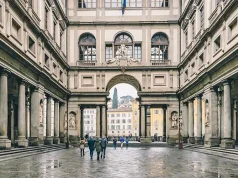
Traveling to southern Italy means entering a universe where everyday life blends with centuries of history and landscapes that seem unreal. From rugged coastlines to baroque cities, every corner carries its own atmosphere. Those who arrive in the south discover that the names so often heard—Sorrento, Amalfi, and Lecce—hold far more than what appears in tourist brochures. And as you walk through narrow streets, cliffs covered with bougainvillea, or ruins open to the sun, a clear sensation emerges: here, every detail tells a story.
Sorrento, between Vesuvius and the sea
Sorrento rises on a natural balcony facing the Gulf of Naples, with the volcano watching in the distance. The first surprise is not the view but the scents: lemons, freshly brewed coffee, and sea salt. The historic center can be explored without a map, among flower-filled balconies, artisan shops, and cafés where time seems to stand still. Piazza Tasso beats like a tireless heart, while from the Villa Comunale the landscape opens toward the horizon with an intensity difficult to describe.
For those seeking an intimate stay, with the calm offered by cliffs and the proximity of the sea, lodging in a place like Hotel Eden in Sorrento can make the difference. It is not only a matter of comfort: the chance to watch each sunset over the Mediterranean from a quiet corner becomes an essential part of the journey.
Amalfi and the thrill of getting lost
The road leading to Amalfi is a spectacle in itself, with impossible curves that reveal views of a sea that seems infinite. Upon arrival, the Duomo dominates with its polychrome façade and endless staircase. But beyond the monument, the true essence of Amalfi lies in its alleys: ancient doors, hidden terraces, cats crossing the cobblestones calmly. The air blends maritime history and contemporary life, as if the past of a powerful republic still breathed in every stone.
Very close by is Atrani, a town so small it feels like a secret shared among few. Ravello, on the other hand, offers a panorama that remains engraved: villas open to the sky and gardens suspended over the coast. Walking through these places feels like every corner prepares a different surprise, a postcard no one had mentioned.
Lecce, baroque as a stage
Further east, in the heart of Apulia, Lecce astonishes with its radiant baroque. The city rises like an open-air museum: carved façades, squares that change color with the light of the day, churches that look embroidered in stone. Strolling at sunset through Piazza del Duomo brings a unique calm, a silence broken only by soft conversations in the cafés. Lecce attracts those seeking less crowded tourism, but also those who know how to appreciate the effortless intertwining of art and daily life.
The trattorias of the old town serve direct, intense flavors, always accompanied by local wines. And the feeling, upon leaving each dinner, is that the city remains alive, waiting for travelers with another nuance the next day.
Islands and horizons
Southern Italy would not be the same without the islands of the Gulf of Naples. Capri dazzles with its glamour, its vertical cliffs, and the famous Blue Grotto. Ischia, instead, is a refuge of vegetation and thermal springs, with villages that still keep a serene pace. Procida, the smallest, preserves intact its seafaring tradition: brightly colored façades, fishing boats, streets filled with the scent of freshly baked bread. Exploring these islands by boat allows you to understand the deep relationship that locals maintain with the sea, as if every wave were part of a collective memory.
From Sorrento, ferries depart in just minutes to Capri, while sunset boat excursions offer another perspective of the coast. Watching the sun disappear behind Vesuvius while sailing off Positano is one of those memories that remain long after returning home.
Among ruins and hidden villages
The journey through the south would not be complete without the ruins of Pompeii and Herculaneum, cities frozen in time by the eruption of 79 A.D. Walking their cobblestone streets, entering houses decorated with frescoes, observing traces of interrupted lives creates a blend of fascination and melancholy.
Far from the crowds, small towns like Sant’Agata or Nerano reveal another side: bakeries closing at midday, fishermen still repairing nets, squares where the dialect resounds strongly. In these places tourism fades and authenticity emerges, that sensation many seek without knowing it.
The south that never ends
Every stop in southern Italy opens a different story: from a limoncello shared on a Sorrento terrace to a walk through Apulian olive groves. It is a journey built in fragments, in small gestures that ultimately compose an unrepeatable mosaic.
And just when you think you have seen it all, a new path appears, a hidden village or a secret viewpoint that once again changes the way you look at this land. The inevitable question is whether one can ever truly know it completely, or if southern Italy always keeps another surprise waiting around the next bend.





